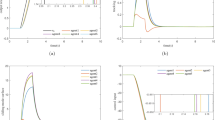Abstract
A recursive terminal sliding mode controller (RTSMC) based on sliding mode disturbance observer (SMDOB) is proposed for the longitudinal dynamics of a generic hypersonic flight vehicles (HFVs) in the presence of parametric uncertainties, measurement noises and external disturbances. First, a sliding mode tracking controller is presented by introducing recursive terminal sliding mode manifolds, in which each manifold will reach zero subsequently in finite time as well as the usual singularity problem will not occur. The RTSMC embraces advantages of both nonsingular terminal sliding mode control and high-order sliding mode control. Next, for the sake of enhancing the robustness of controller for uncertainties, a SMDOB is proposed to estimate and compensate the disturbances. Then, a composite controller that is composed of RTSMC and SMDOB is designed, and its stability is analyzed utilizing Lyapunov function method. Finally, numerical simulation is conducted for cruise flight condition of HFV. Simulation results show the expected control performance.











Similar content being viewed by others
References
Chavez, F.R., Schmidt, D.K.: Analytical aeropropulsive/aeroelastic hypersonic vehicle model with dynamic analysis. J. Guid. Control Dyn. 17(6), 1308–1319 (1994)
Bolender, M.A., Doman, D.B.: A non-linear model for the longitudinal dynamics of a hypersonic air-breathing vehicle. Defense Technical Information Center (2006)
Bolender, M.A., Doman, D.B.: Nonlinear longitudinal dynamical model of an air-breathing hypersonic vehicle. J Spacecr. Rockets 44(2), 374–387 (2007)
Marrison, C.I., Stengel, R.F.: Design of robust control systems for hypersonic aircraft. J. Guid. Control Dyn. 21(1), 58–63 (1998)
Wang, Q., Stengel, R.F.: Robust nonlinear control of a hypersonic aircraft. J. Guid. Control Dyn. 23(4), 577–585 (2000)
Groves, K.P., Sigthorsson, D.O., Serrani, A., Yurkovich, S.: Reference command tracking for a linearized model of an air-breathing hypersonic vehicle. In: AIAA Guidance, Navigation, and Control Conference and Exhibit, San Francisco, CA (2005)
Parker, J.T., Bolender, M.A., Doman, D.B.: Control-oriented modeling of an air-breathing hypersonic vehicle. J. Guid. Control Dyn. 30(3), 856–869 (2007)
Xu, H., Mirmirani, M.D., Ioannou, P.A.: Adaptive sliding mode control design for a hypersonic flight vehicle. J. Guid. Control Dyn 27(5), 829–838 (2004)
Rehman, O.U., Fidan, B., Petersen, I.R.: Uncertainty modeling and robust minimax LQR control of multivariable nonlinear systems with application to hypersonic flight. Asian J. Control 14(5), 1180–1193 (2012)
Rehman, O.U., Petersen, I.R., Fidan, B.: Robust nonlinear control design of a hypersonic flight vehicle using minimax linear quadratic Gaussian control. In: 49th IEEE Conference on Decision and Control, Atlanta, GA, USA, pp 6219–6224 (2010)
Rehman, O.U., Petersen, I.R., Fidan, B.: Feedback linearization-based robust nonlinear control design for hypersonic flight vehicles. Proc. IMechE Part I: J Syst. Control Eng. 227(1), 3–11 (2012)
Hu, X., Karimi, H.R., Zhang, Z., Gao, H.: Non-fragile sliding mode control for flexible air-breathing hypersonic vehicles. In: 7th IEEE Conference on Industrial Electronics and Applications (ICIEA), Singapore, pp. 906–911 (2012)
Durmaz, B., Özgören, M.K., Salamci, M.U.: Sliding mode control for non-linear systems with adaptive sliding surfaces. Trans. Inst. Meas. Control 34(1), 56–90 (2012)
Hu, X., Wu, L., Hu, C., Gao, H.: Adaptive sliding mode tracking control for a flexible air-breathing hypersonic vehicle. J. Franklin Inst. 349, 559–577 (2012)
Yu, X., Zhihong, M.: Fast terminal sliding-mode control design for nonlinear dynamical systems. IEEE Trans. Circuits Syst. I Fundam. Theory Appl. 49(2), 261–264 (2002)
Yu, S., Yu, X., Shirinzadeh, B., Man, Z.: Continuous finite-time control for robotic manipulators with terminal sliding mode. Automatica 41, 1957–1964 (2005)
Feng, Y., Yu, X., Man, Z.: Non-singular terminal sliding mode control of rigid manipulators. Automatica 38, 2159–2167 (2002)
Li, H., Dou, L., Zhong, S.: Adaptive nonsingular fast terminal sliding mode control for electromechanical actuator. Int. J. Syst. Sci. 44(3), 401–415 (2013)
Zhang, R., Sun, C., Zhang, J., Zhou, Y.: Second-order terminal sliding mode control for hypersonic vehicle in cruising flight with sliding mode disturbance observer. J. Control Theory Appl. 11(2), 299–305 (2013)
Zong, Q., Wang, J., Tian, B., Tao, Y.: Quasi-continuous high-order sliding mode controller and observer design for flexible hypersonic vehicle. Aerosp. Sci. Technol. 27, 127–137 (2013)
Sun, H., Li, S., Sun, C.: Finite time integral sliding mode control of hypersonic vehicles. Nonlinear Dyn. 73, 229–244 (2013)
Wilcox, Z.D., MacKunis, W., Bhat, S., Lind, R., Dixon, W.E.: Lyapunov-based exponential tracking control of a hypersonic aircraft with aerothermoelastic effects. J. Guid. Control Dyn. 33(4), 1213–1224 (2010)
Slotine, J.-J.E., Li, W.: Applied Nonlined Control. Pearson Education Inc, New York (1991)
Hu, S.: Automatic Control Theory. Science Press, Beijing (2000). (in Chinese)
Polyakov, A., Poznyak, A.: Reaching time estimation for “Super-Twisting” second order sliding mode controller via Lyapunov function designing. IEEE Trans. Autom. Control 54(8), 1951–1955 (2009)
Chiu, C.-S.: Derivative and integral terminal sliding mode control for a class of MIMO nonlinear systems. Automatica 48, 316–326 (2012)
Hall, C.E., Shtessel, Y.B.: Sliding mode disturbance observer-based control for a reusable launch vehicle. J. Guid. Control Dyn. 29(6), 1315–1328 (2006)
Acknowledgments
This work was supported by the National Natural Science Foundation of China (91216304).
Author information
Authors and Affiliations
Corresponding author
Appendices
Appendix 1
The detailed expressions of the vectors \({\varvec{\Omega }}_{1}, \varvec{\Pi }_{1}\) and matrices \({\varvec{\Omega }}_{2}, \varvec{\Pi }_{2}\) are as follows:
where
Appendix 2
Without loss of generality, the angle of attack and flight path angle are assumed near this singularity to be
where \(\varepsilon \) is a small positive number.
Then,
where \(\sigma =\frac{\partial \left( {\frac{1}{2}\rho V^{2}SC_D } \right) }{\partial \alpha }\) and which is a small real number.
In the above case, \(b_{11}\) is equal to \(b_{21}\), and the matrix \(\mathbf{B}\) will be singular if \(b_{12} =b_{22} =0\). Therefore, we give \(b_{12}\) and \(b_{22}\) some restrictions near the singularity, namely
moreover, \(\delta _1^*\ne \delta _2^*, b_{12} \ne b_{22}\).
In that way, the matrix
And the controller in the paper can be used.
Rights and permissions
About this article
Cite this article
Wang, J., Wu, Y. & Dong, X. Recursive terminal sliding mode control for hypersonic flight vehicle with sliding mode disturbance observer. Nonlinear Dyn 81, 1489–1510 (2015). https://doi.org/10.1007/s11071-015-2083-4
Received:
Accepted:
Published:
Issue Date:
DOI: https://doi.org/10.1007/s11071-015-2083-4




